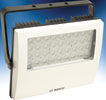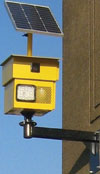

New solid-state lighting technology delivers added benefits and opportunities to the security industry.
The lighting industry is not alone in benefiting from the development of high-power light emitting diodes (LEDs). The security industry has fast come to recognise the benefits of switching to LED-based illumination. These LED platforms deliver operational lifetimes of up to 50 000 hours – 50 times that of traditional lamps and consume less than 20% of the power for the same illumination levels. This translates into dramatically reduced running costs and lower CO2 emissions.
For the lighting industry, the development of white LEDs (phosphor-coated blue LED dies) was the big driver for the changeover. Before the development of blue LEDs in the mid 1990s made the generation of white light possible, the only LEDs available were infra-red and through red to green, from which it is impossible to generate white light.
Even before the breakthroughs in white-LED technology, security system manufacturers had begun to make use of high-power infra-red LED illuminators for covert CCTV surveillance. Infra-red, which is invisible to the human eye when used with low light cameras, enables true night-time surveillance. This security lighting, specifically designed for CCTV, initially used tungsten-halogen based illuminators and later illuminators based on infra-red powered LEDs. You could say in fact that security systems manufacturers were already a step ahead of the lighting industry in the use of LED illumination.
Following the development of the white LED, security systems manufacturers were able to extend the application of security lighting to cover night-time colour imaging. This became possible thanks to the fact that the spectral output of white LEDs follows the photopic curve – describing the colour response of the human eye and of colour camera more closely than incandescent light sources – and hence is better able to produce accurate renditions of the colours in a CCTV scene. By contrast, the spectrum of high-power sodium lamps peaks in the yellow and metal halide lamps peak in the blue, neither of which are beneficial to colour CCTV, as they cause major shifting of the colours within scene.

Safety lighting goes solid state
Security systems manufacturers like Bosch are also developing white-LED based safety lighting systems, used to illuminate perimeter fencing and critical infrastructures such as power stations, rail networks and airports. To put the potential savings achievable by white-LED based systems in perspective, consider a perimeter fence of typically 50 km illuminated along its length by 1 kW metal-halide safety lights, every 40 m. This makes a total of 1250 lamps and a total power consumption of 1,25 MW. Replacing these metal-halide lamps with white-LED illuminators, which produce the same illumination level but with a power consumption of only around 35 W, reduces the consumption to around 44 kW. In real terms this is a saving of nearly 97% in electrical running costs. In addition to savings on power are the savings possible in maintenance costs. Metal-halide lamps burning approximately 12 hours a day will need replacing every six months. In contrast, Bosch’s AEGIS white LED illuminators will operate for a minimum of five years without degradation. These are potential cost-savings no administrator of a large site can possibly ignore.
Moreover, the light distribution of an LED-based illuminator can be more precisely controlled than with traditional light sources. This helps to eliminate light pollution as the light can be directed precisely on the scene instead of being thrown skyward and to surrounding areas where it will add to light pollution (as well as wasting more than 30% of the energy consumed). The safety of an area is enhanced when directional light is used as areas are more evenly illuminated with fewer shadows.
Double the cost-savings
Advances in high-power white LED technology has led to another interesting development. In the past, separate installations were needed for security and safety lighting. This was unavoidable, of course, since the spectral output of high-power sodium and metal-halide lamps (traditionally used for safety lighting) are not suitable for colour CCTV. With white LED illuminators, however, it is now possible to combine security and safety lighting in a single installation, thanks to the white LEDs spectral output which is ideal for colour CCTV imaging. The benefits are obvious and include significantly lower hardware and installation costs, since one installation can now perform both tasks and lead to further reductions in energy consumption.
End users have been quick to recognise these benefits and all predictions point to a thriving new market developing for security systems manufacturers.
Extreme performance
LED lighting technology not only provides better economy and longer operational lifetimes than traditional lighting technologies, the products are intrinsically more robust with better shock resistance. They are therefore better suited for use in areas prone to vibration such as road bridges, poles, pylons, wind turbines, ships and rail networks. A disadvantage, however, is that like all semiconductor devices their performance is temperature sensitive and the output will degrade over time. The ageing effect is rather dramatic as LEDs output can degrade by around 10% in the first six months of operation and then continue to degrade over the rest of the units lifetime.
This disadvantage is overcome by Bosch’s AEGIS infra-red and white-light which have been specifically designed to combat LED degradation and temperature fluctuation. AEGIS features a feedback circuit that compensates for any degradation in light output caused by increasing temperatures and ageing. This patent-pending technology is known as Constant Light. The system continuously measures the light output from the LEDs and automatically adjusts the drive current to maintain light output at a constant level. With Bosch’s Constant Light technology, the light output of the AEGIS illuminator is guaranteed to remain constant at temperatures of +50° Celsius.
AEGIS also features 3D diffuser (Black Diamond) technology which delivers uniform illumination to a scene. This ensures that all radiant energy emitted by the LEDs is directed at the scene with no leakage skywards as happens with circular emitting illuminators. What is more, the illumination is evenly distributed between the foreground and background, eliminating hotspots and foreground overexposure and allowing the camera to operate correctly within its dynamic range. The net effect of this technology is increased dynamic range and better CCTV imaging.
For more information contact Bosch Security Systems - South Africa & Sub-Sahara Africa, +27 (0)11 651 9818, [email protected] , www.boschsecurity.co.za
| Tel: | +27 11 651 9600 |
| Email: | [email protected] |
| www: | www.boschsecurity.com/xf/en |
| Articles: | More information and articles about Bosch Building Technologies |

© Technews Publishing (Pty) Ltd. | All Rights Reserved.